Key Elements for a Kitesurfing Beginner Kit
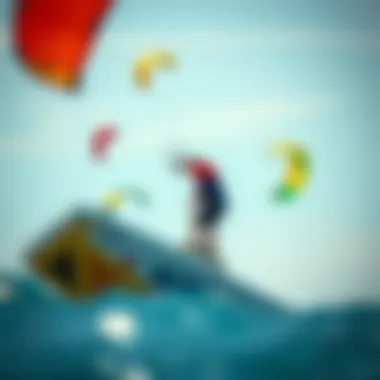
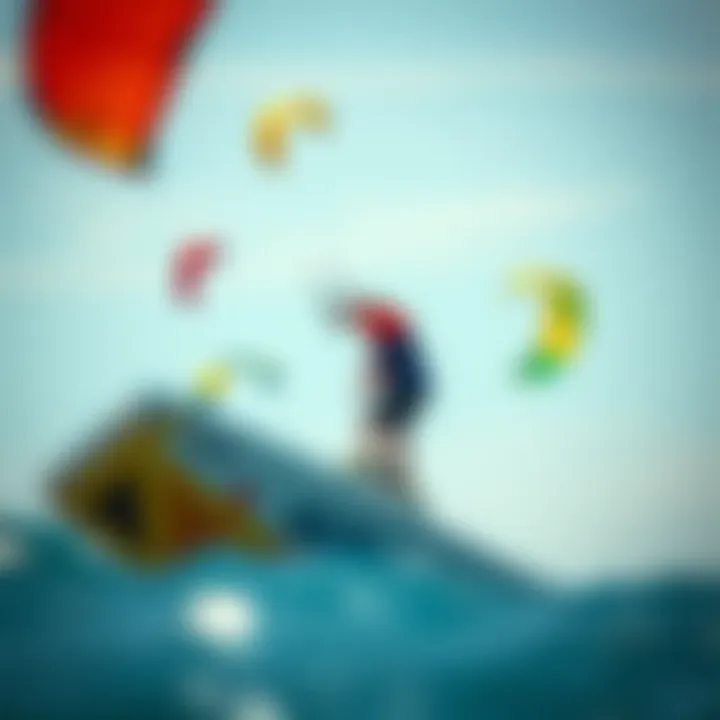
Intro
Kitesurfing, a thrilling fusion of surfing, windsurfing, and paragliding, offers adventure seekers a unique way to harness the power of the ocean and wind. For those eager to take their first plunge into this exhilarating sport, understanding the essential components of a beginner’s kitesurf kit is crucial. This guide wraps around the key gear needed for a safe and enjoyable experience, covering everything from kites and boards to harnesses and safety measures.
Each piece of equipment plays a vital role, ensuring that novices can navigate the waters with confidence. Whether you’re looking to cruise along the shoreline or catch some air, having the right kit is the foundation of those dreams. Additionally, safety never takes a backseat in kitesurfing, making it essential to be informed about the gear that keeps you in check. As we unpack the elements of your kitesurf kit, you’ll discover what’s necessary for a fun and safe outing on the water.
Understanding Kitesurfing
Kitesurfing is more than just a sport; it’s a thrilling blend of wind, water, and skill. Understanding the fundamentals of kitesurfing is paramount for anyone looking to dip their toes—or rather, their entire selves—into this exhilarating activity. This section is designed to shed light on the core principles and vital considerations that govern the kitesurfing experience, ensuring that newcomers grasp the essential elements before they hit the water.
One might wonder why it's so crucial to understand kitesurfing in depth. Initially, recognizing the dynamics of wind and water can significantly enhance your performance and enjoyment. A seasoned kitesurfer knows that the rhythm of the waves and the whispers of the wind dictate how you ride and maneuver your board. Understanding these elements allows a beginner to intuitively gauge conditions and adapt their technique on the fly.
Moreover, kitesurfing isn't just about the physical act of surfing on water with a kite; it's also an intricate dance of safety and control. A firm grasp of how the equipment operates—like the kite, board, and harness—can be the key to avoiding mishaps. Beginners should appreciate that each piece of gear plays a role, and mastering the basics will ensure a smoother transition into this picturesque world of kitesurfing.
In summary, understanding kitesurfing encompasses various layers—technical skills, environmental awareness, and safety considerations. Each element contributes to a well-rounded experience, paving the way for enjoyment and growth in this captivating sport.
The Basics of Kitesurfing
At its core, kitesurfing involves using a large, controllable kite to harness wind power while gliding across water on a board. The principles might seem simple, but as with many sports, the beauty lies in its nuances. For instance, knowing how to position your body in relation to the kite as it catches the wind can mean the difference between soaring high or crashing hard.
Kitesurfing typically takes place in locations with consistent winds and open waters, making places like beaches ideal spots. A calm sea with decent winds is a beginner's best friend, allowing one to practice fundamental skills, such as body dragging and water starts.
Here’s a quick overview of essential aspects:
- The Kite: This is your primary tool for propulsion. It comes in various shapes and sizes, catering to different skill levels and conditions.
- The Board: This is where you stand while gliding across the water. Boards differ in size, shape, and style, impacting speed and maneuverability.
- The Harness: This piece connects you to the kite and distributes the forces exerted by the wind more evenly across your body, allowing for better control.
For individuals embarking on this journey, being acquainted with these elements not only provides foundational knowledge but also enhances overall confidence when faced with real-world conditions on the water.
Kitesurfing Terminology
Familiarizing oneself with kitesurfing terminology is fundamental as it opens the door to effective communication and a deeper understanding of the sport. Here’s a selection of key terms that every beginner should know:
- Wind Window: This is the area in which the kite can be flown, typically in front of and above the rider.
- Depower: This refers to the ability to adjust the power of the kite, allowing the user to ride more safely and manage their speed.
- Body Dragging: A technique used to retrieve the board after a fall, wherein the rider uses the kite's power to be pulled through the water.
- Downwind: The direction in which the wind is blowing; moving downwind typically means that the kite is being flown in the same direction as the wind.
Understanding these terminologies not only makes learning easier but also makes discussions with instructors and other kitesurfers more productive. The more one engages with the language of the sport, the quicker one can elevate their skills and comprehension.
"Knowledge is the key that unlocks the door to mastery in kitesurfing." - Anonymous
In the beautiful realm of kitesurfing, grasping the basics and the lingo sets a sturdy foundation that will serve any beginner well as they progress. Thus, it becomes clear that what lies beneath the surface of this sport is a rich tapestry of knowledge, commitment, and excitement.
Components of a Kitesurf Beginner Kit
When venturing into kitesurfing, having the right kit is as critical as understanding the wind patterns. The components of a kitesurf beginner kit serve as the backbone of a successful and enjoyable experience on the water. A carefully selected set of equipment not only enhances a newbie’s ability to learn but also minimizes potential risks associated with the sport. Each piece plays its role, whether it’s providing the necessary lift to catch a gust or the stability to ride confidently on the waves. Therefore, examining the individual components will shed light on how they contribute to the overall experience.
Kites
Types of Kites
Understanding the various types of kites is fundamental for any beginner. The most common types one encounters include inflatable kites and foil kites. Inflatable kites, as the name suggests, are filled with air, making them buoyant and resilient. They are often favored by novices due to their ease of use and simple re-launching capabilities when fallen. Foil kites, while generally lighter and more compact, may require a tad more finesse and can suit those who progress quickly.
When thinking about kites, consider their versatility too. An inflatable kite, for instance, typically flourishes in varying wind conditions, making it a reliable choice for those just starting. Thus, the ability to adapt to different scenarios can be invaluable; it can provide a smoother transition from learning to mastering kitesurfing.
Kite Sizes Explained
The size of the kite you choose plays a pivotal role in your riding experience. Smaller kites are easier to handle, particularly in higher winds, while larger kites provide more power but can be unwieldy in strong gusts. Newcomers often find kites ranging from 7 to 12 meters to be suitable, but local wind conditions can heavily influence this decision.
Another key point is that larger kites give more lift, which could be enticing for someone keen on jumping. However, excessive lift can also be intimidating if control isn’t yet mastered. This balancing act between size and control will be a focal point for beginners.
Choosing the Right Kite
Selecting the right kite is a nuanced process influenced by personal factors and environmental conditions. Beginners should consider weight, skill level, and common wind conditions at their local spots. One might lean towards a stable, forgiving kite for initial sessions all while keeping in mind the potential for fast progress in skill.
The key characteristic here is finding a kite that feels intuitive—there's nothing better than one that responds well to your movements. The right kite will aid in skill development, providing that crucial combination of power and control that is so sought-after in one’s learning journey.
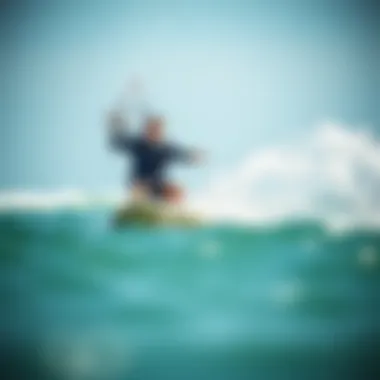
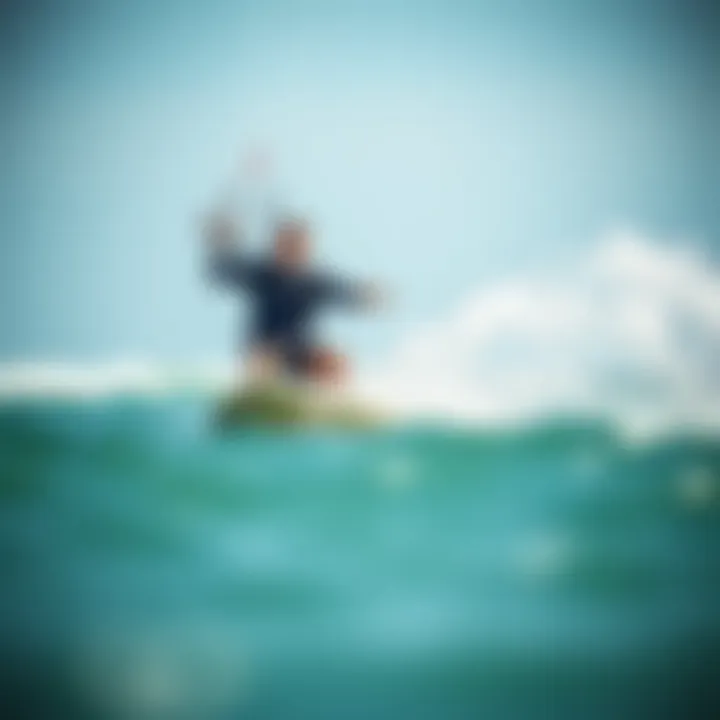
Kiteboards
Different Types of Boards
Kiteboards come in several varieties, including twin-tips and directional boards. Twin-tips are often the go-to for beginners because of their versatility. These boards allow for easy navigation and tricks, giving new riders the chance to experiment on the water without facing a steep learning curve. Directional boards, on the other hand, resemble surfboards and are best suited for those who want to ride waves, but they require a bit more experience and skill.
A twin-tip board helps in building fundamental skills, making it easier for beginners to enjoy their time out on the water without getting bogged down too much by details.
Board Size Considerations
Choosing the right size board is another nuanced aspect. Board sizes generally range from 130 to 150 cm, but the appropriate size hinges on the rider's weight and local conditions. Heavier riders often need larger boards to ensure adequate flotation, while lighter riders can manage with smaller boards.
Moreover, a larger board can provide more stability in choppy waters, which is essential for someone just getting their sea legs. That said, a board that feels too big can hinder control and maneuverability, so it’s a balancing act to find that sweet spot.
Selecting Your First Board
When it comes time to select your first board, it’s essential to stay true to the principle of beginners—simplicity is key. A beginner-friendly board should offer a mix of stability and responsiveness while fostering confidence. The twin-tip style, often recommended, caters to skill development without overly complicating the learning process. Look out for a board that provides a forgiving feel; it should help absorb the little bumps and jitters of learning as much as possible.
Harnesses
Types of Harnesses
Harnesses come in two main varieties: seat harnesses and waist harnesses. Seat harnesses offer lower back support and are generally preferred by beginners because they tend to hold the rider upright, making it less likely to be pulled off balance. Waist harnesses, while popular amongst experienced kitesurfers for their mobility and range of motion, can be harder to handle for a novice as they require more core engagement.
Both types have their place, but beginners often find they prefer seat harnesses for simplicity.
Proper Fit and Comfort
Comfort is crucial when it comes to harnesses. A snug but not tight fit is ideal. Harnesses often come equipped with straps and adjustments to ensure a custom fit. If the harness pinches or rides up during use, it's a guarantee that will cause distraction, taking you away from focusing on riding.
Finding a harness that feels like a second skin will greatly enhance your riding experience and help in reducing despair during those early sessions.
Safety Features to Look For
It’s worth considering the safety features inherent in harness designs. Many models include quick-release mechanisms, ensuring that a rider can detach swiftly in emergencies. Additionally, look for reinforced stitching and durable materials if you want longevity. A harness that meets safety standards can bolster a rider’s confidence, knowing they’re secure while they’re embracing the thrill of kitesurfing.
Control Bars
Understanding Control Bars
Control bars are the direct link between the rider and the kite. They allow steering and control over the kite’s angle relative to the wind direction. Their construction will typically match the kite size and type, making it important to ensure that you do’t end up with a bar system that feels off-balance.
An effective control bar provides predictability, which is essential for beginners as they learn how to manipulate the kite. Getting accustomed to how a control bar handles under various conditions is a vital part of learning how to ride.
Adjustable Features
One of the most beneficial attributes of control bars is their adjustability. Bars with adjustable widths can cater to different styles and kites, allowing for more versatility as a rider progresses. Such adjustable features enable a beginner to tailor their equipment as they grow and learn.
These settings also allow for fine-tuning based on wind conditions, making it simpler to handle when learning. Novices will often appreciate having this flexibility.
Importance of Lines
The lines connecting the control bar to the kite play a vital role in responsiveness. The material should be durable while also being lightweight to facilitate easy maneuverability. Different types of lines can vary in length and material, which can strongly impact how the kite reacts to input from the control bar.
High-quality lines can mean the difference between a responsive kite and one that feels sluggish, so investing in good lines is another step towards ensuring an optimal learning experience for beginners.
Safety Equipment
In the thrilling realm of kitesurfing, safety equipment isn't just a nice-to-have; it's a must. Proper safety gear goes beyond being a mere accessory—it’s essential for protecting yourself from the myriad of potential hazards you might encounter on and off the water. It offers peace of mind, allowing you to focus on honing your skills and enjoying the ride. Let's examine the crucial elements that every kitesurfing beginner should consider in their safety arsenal.
Personal Flotation Devices
Types of Life Jackets
When it comes to life jackets, not all are created equal. Beginners should consider options such as inflatable vests or traditional buoyancy aids. Inflatable life jackets may be popular due to their sleek design and comfort, allowing for better mobility while practicing. They also tend to provide better warmth in cooler waters. However, one must keep in mind that these devices require a manual inflation process in case of an emergency, which may involve fumbling during critical moments.
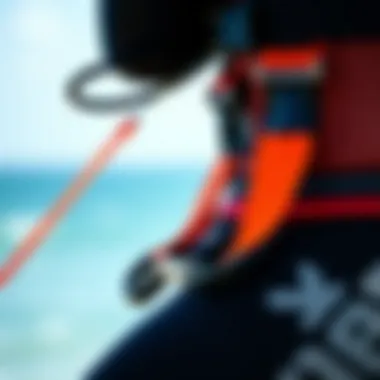
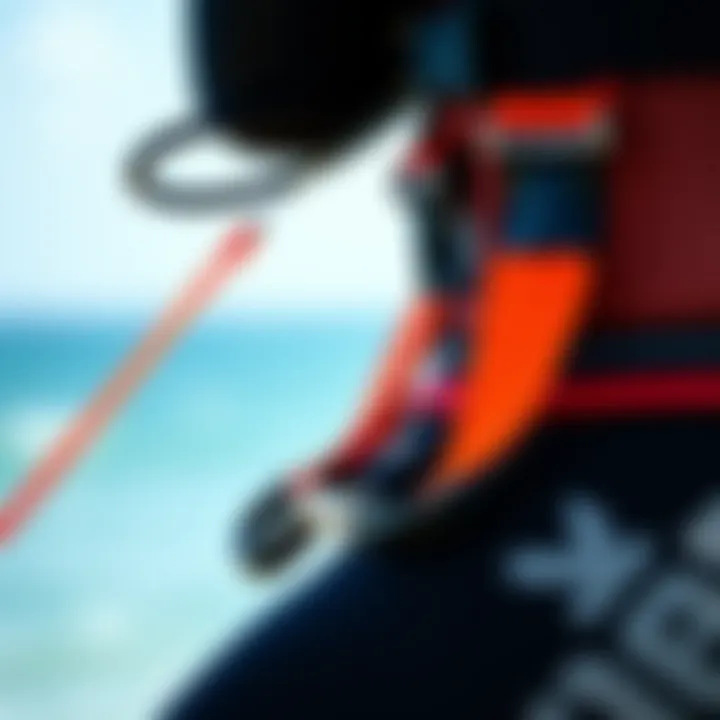
On the other hand, buoyancy aids, which fit snugly and are lighter, are great for enhancing freedom of movement while still providing adequate flotation. Yet, they generally offer less protection than their inflatable counterparts against rough waters. Choosing the right life jacket boils down to knowing your comfort level on the water and the environment you'll be kitesurfing in.
Regulations and Recommendations
Every region has its own set of rules when it comes to kitesurfing safety gear. It's vital to familiarize yourself with any local regulations pertaining to flotation devices. For instance, certain areas may require life jackets to have a minimum buoyancy rating or specific design features. The key characteristic here is compliance with safety standards, which ultimately facilitates a sense of security on the water.
In addition to regulations, recommendations from experienced surfers or instructors can prove invaluable. They often suggest brands or specific types of jackets that perform well in local conditions, making them a practical choice for beginners. Ignoring these guidelines could not only violate local laws but also compromise your safety while out kitesurfing.
Safety Leashes
Functionality of Safety Leashes
Safety leashes serve as a critical link between the kiter and the kite. This gear is designed to reduce the risk of losing control of the kite during sudden falls or unexpected scenarios. A well-constructed safety leash typically features a quick-release mechanism, which allows the rider to detach from the kite swiftly. This can be a lifesaver in situations where a rapid response is required.
Furthermore, some safety leashes have additional features like adjustable lengths, which can accommodate different riding styles and preferences. However, one must be careful as a leash that is too long could restrict your ability to react quickly should something go south. Proper knowledge of how to use these leashes effectively can make all the difference while mastering kitesurfing.
Choosing the Right Leash
The selection of a safety leash can sometimes feel overwhelming for novices. Opting for a leash that is both comfortable and functional can enhance your overall experience. Special attention should be put into features such as quick-release capability and sturdy construction. These traits ensure that you’re not just safely tethered but also able to disengage the kite easily when necessary.
An additional factor is to consider the leash's connection to your harness. Some leashes utilize a simple snap mechanism while others may require more complex attachment processes. Understanding these details can aid immensely in ensuring a smooth ride. Ultimately, finding the right leash is about striking a balance between safety, comfort, and usability.
Helmets and Impact Vests
Importance of Head Protection
A helmet is often overlooked in kitesurfing safety gear, yet it is indispensable. Whether fighting strong wind or navigating tricky water conditions, a helmet can notably reduce the risk of sustaining a serious head injury from unexpected impacts—be it from the board, a fall, or natural elements. The primary characteristic of helmets is their ability to absorb shocks and distribute the force over a greater surface area, significantly minimizing potential damage.
When choosing a helmet, look for one that is lightweight but sturdy, yet still providing excellent coverage and fit. A secure and comfortable fit will encourage you to wear it consistently. Ignoring this simple protective measure might cloud your session with worry, which can, in turn, hinder performance.
Adding Impact Resistance
In kitesurfing, an impact vest serves to cushion your body against sudden jolts and accidents. When planned properly, these vests enhance safety without sacrificing mobility. Designed with sleek profiles and buoyant materials, they provide both comfort and a layer of protection to your torso.
The unique feature of many modern impact vests is their lightweight design amalgamated with superior impact absorption materials like EVA foam. Choosing one with CE certification ensures that it meets safety standards, providing a reliable level of protection. However, one should also examine trade-offs; while choosing a vest that is overly padded might offer more protection, it can restrict movement and hinder performance. Thus, balance is essential.
Instructional Resources
Understanding the importance of instructional resources is key for any beginner venturing into the world of kitesurfing. This section emphasizes how proper guidance not only accelerates the learning process but also fosters safety and good habits from the very start. The following subheadings explore various avenues through which newcomers can gain knowledge and skills essential for their kitesurfing journey.
Kitesurfing Lessons
Finding Certified Instructors
One of the first steps in kicking off a kitesurfing adventure is finding certified instructors. The credibility of these professionals often sets the stage for a safe and informed experience on the water. A certified instructor has typically completed a recognized training program, such as those offered by the International Kiteboarding Organization (IKO) or similar entities. This aspect bears significant weight as an instructor’s expertise ensures adherence to best practices in terms of safety and skill development.
Experienced instructors also bring unique perspectives and techniques to their lessons, which is a pivotal contribution to the novice’s learning curve. They can tailor their teaching style to accommodate individual learning preferences, making the experience more enjoyable and effective. However, it's also crucial to choose an instructor who embodies patience and clarity in their communication. Without a good rapport, learning can feel like wading in molasses. Be sure to reach out and even watch a lesson if possible, to ascertain their teaching style matches what you’re looking for.
Lesson Structure and Expectations
Understanding the lesson structure and expectations is another essential part of a beginner's education in kitesurfing. Typically, lessons might begin with dry land training, where students familiarize themselves with the kite and its controls before hitting the water. This grounded phase is essential - it's like figuring out the way before driving a car.
Expect lessons to balance theory and practice, covering topics like weather conditions, board handling, and kite control. This mix helps create a well-rounded foundation. Those returning for subsequent lessons are often encouraged to recap what they’ve learned before progressing, reinforcing their memory and skills. While this may appear obvious, beginners sometimes overlook the benefit of repetition. Understanding that expectations will evolve as skills develop keeps motivation high. Nearing the end of your lessons, you might feel a tinge of apprehensiveness, but know that having this solid groundwork alleviates most jitters.
Online Tutorials and Videos
Recommended Channels
In today’s digital age, recommended channels for online tutorials and videos serve as invaluable resources for beginners. These platforms, like YouTube or specialized kitesurfing websites, are rich with visual and instructional content that can be accessed anytime, making learning flexible. You might stumble upon channels where experienced kitesurfers share tips, tricks, and walkthroughs of challenging maneuvers like jumps or transitions.
The beauty of these resources lies in their accessibility; practicing in your own space at your own pace can significantly enhance the hands-on experience. Channels featuring comprehensive playlists can guide learners through various stages of skill acquisition, from basics to more advanced techniques. However, with an overflow of information available, it’s crucial to select reputable channels with verified content. Lurking through the comments section can offer insights into the reliability and effectiveness of the tutorials. Remember, not all that glitters is gold - some advice might be better suited for intermediate surfers than absolute newbies.
Learning Techniques
The learning techniques presented through these online platforms hold substantial contributions to a beginner's kitesurfing education. Video tutorials that break down complex movements into digestible parts can demystify the intricacies of kitesurfing. For instance, seeing a slow-motion replay of a particular jump can enlighten a beginner on timing, technique, and posture.
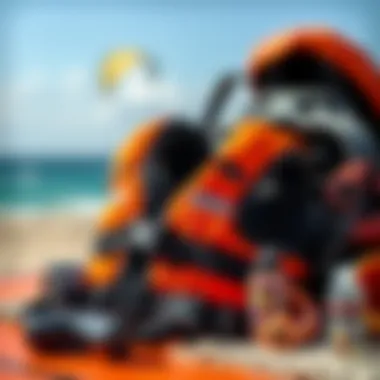
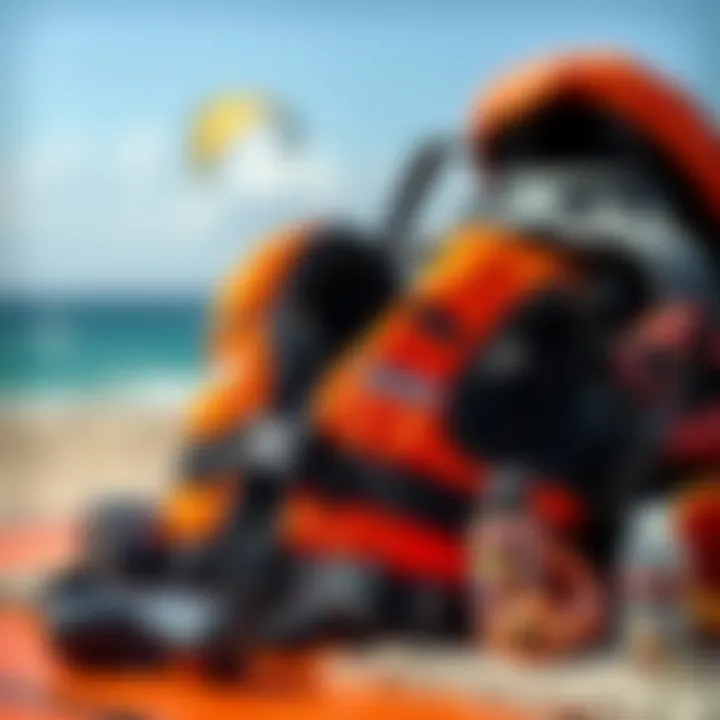
Variable techniques such as visual learning, physical practice, and community discussions encourage an interactive learning experience. Engaging with fellow learners through comments or forums can clarify doubts while enriching the journey. However, a potential drawback exists in the form of information overload. Without proper discernment, one might find themselves muddled with conflicting methods and advice. Establishing a clear focus by sticking to a few solid resources can streamline the learning curve.
By leveraging both in-person lessons with credible instructors and a plethora of online resources, newcomers to kitesurfing are well-equipped to navigate their way through this thrilling sport, setting themselves up for consistent improvement in their skills.
Maintenance of Kitesurfing Gear
Keeping your kitesurfing gear in good condition is crucial for ensuring that you enjoy safe and effective sessions on the water. Regular maintenance not only prolongs the life of your equipment but also enhances your overall performance and safety during your kitesurfing adventures.
Badly maintained gear can lead to failures, injuries, and costly replacements. That’s why understanding how to properly care for your kite, board, and harness is essential, especially for newcomers who might not yet be familiar with the rigors of the sport.
Cleaning and Storage
Cleaning Techniques
Cleaning your kitesurfing gear after every session is non-negotiable. Saltwater and sand can quickly wreak havoc on your kite, board, and other components. The best cleaning technique involves rinseing your equipment with fresh water as soon as possible after use. This simple yet effective action removes salt and prevents corrosion.
Key Characteristic: It’s recommended to use a gentle brush to scrub off stubborn sand or dirt, especially in areas like the seams of your kite or the bottom of your board.
This method ensures that you catch potential issues before they worsen with time. The unique feature of thorough cleaning is that it not only maintains aesthetics but also functionality. A clean kite has better airflow, which translates into better performance. However, over-cleaning can wear out some materials, so be cautious about how you treat sensitive areas.
Proper Storage Solutions
Once clean, how you store your gear is just as important. A proper storage solution means keeping your equipment safe from harsh conditions that could degrade the materials. Always store your kite in a cool, dry place away from direct sunlight. Ideally, use a padded bag specifically designed for kites to offer that extra layer of protection.
Key Characteristic: Proper folding techniques significantly reduce creasing and strain on your gear. Essentially, you want to avoid any twists and turns that could lead to issues down the line.
A unique aspect of good storage practices is their ability to deter pests and other elements. Taking the time to neatly pack your gear minimizes the likelihood of damage and extends the gear's lifespan, making it a highly beneficial approach.
Inspection and Repairs
Regular inspections and knowing basic repair techniques can save you a world of trouble on the water. Timely inspections allow you to catch any wear and tear before hitting the waves, reducing your risk of unexpected failures.
Regular Gear Inspections
Performing routine checks on your kitesurfing gear is vital. Look for any frays in your lines or nicks on your kite’s leading edge. A thorough inspection should involve checking bar and line connections, as well as your harness straps.
This proactive approach is beneficial as it enhances your safety and ensures you maximize your gear's performance. A unique feature of regular inspections is that they become a habit over time. As you learn to spot potential issues, it becomes second nature, preparing you better for all conditions.
Basic Repair Techniques
Basic repair techniques are necessary skills every kitesurfer should master. Having a repair kit that includes patches, line connectors, and a sewing needle can save a session if something breaks.
For instance, patching a small tear on your kite can be done easily with a patch kit, allowing the gear to remain serviceable until a proper repair can be made. Being able to handle minor repairs can save you from an early day at the beach. The key characteristic of knowing basic repair techniques is the independence it provides; you aren’t relying on others to get you back on the water.
However, it's vital to know when a repair isn't enough and a professional fix is needed. Over-optimizing small issues can sometimes lead to bigger problems, so a balanced approach is essential.
"Your kitesurfing gear is your lifeline. Treat it like you would a trusted friend—care for it, and it will care for you."
By instituting proper cleaning, storage, regular inspection, and basic repair techniques, kitesurfing newcomers can enjoy a seamless and enjoyable experience on the water. The attention you pay to your equipment translates directly into better performance and, above all, a safer kitesurfing experience.
Finale
Reconciling all that’s been discussed, the conclusion of this article synthesizes the essentials for a kitesurf beginner kit. Understanding the individual components is akin to fitting pieces into a puzzle; each part plays a crucial role in ensuring a safe, enjoyable, and successful experience on the water. The elements—kites, boards, harnesses, and safety gear—aren’t just mere accessories; they are fundamental to building your skillset and confidence as you embark on your kitesurfing journey.
Recap of Essential Items
To summarize the pivotal components of this journey, here's a comprehensive look at the essential items:
- Kites: Your primary tool for harnessing wind power. Types and sizes will heavily depend on your skill level and the conditions you'll be riding in.
- Kiteboards: The board is where you'll stand. Choose one that suits your weight and preferences, as it will directly influence your ride.
- Harnesses: Vital for connecting you to the kite, ensuring you stay in control and reducing fatigue.
- Control Bars: The steering system of your kite, allowing you to manage power and direction.
- Safety Gear: Including personal flotation devices, safety leashes, and helmets to safeguard against potential mishaps.
"Gear isn’t everything, but having the right equipment sets the foundation for mastering a new sport."
Embracing the Kitesurfing Journey
The journey into kitesurfing may seem daunting at first glance, but breaking it down into manageable pieces makes it accessible for anyone. Each session on the water transforms not just your skills, but your outlook. It’s more than just sport; it’s about the exhilaration of gliding through the waves and the camaraderie among fellow enthusiasts. Building familiarity with your gear, understanding your limits, and learning the tricks of the trade will evolve into a rewarding experience.
Adopting a mindset open to learning can elevate your kitesurfing experience. Whether you’re tackling the slightest of breezes or catching waves, each ride introduces new challenges and rewards. Embrace the stumbles—every one is a step towards mastery. Stick with it, invest in your gear wisely, and seek out community tips and resources. The world of kitesurfing has more to offer than simply the thrill; it’s a lifestyle that connects you to the outdoors, to nature's elements, and to a global network of passionate riders.
Continually seek knowledge, whether through lessons or community forums, as that can enhance your confidence and skills. Engage with resources like Reddit's kitesurfing community or kitesurfing schools listed on reputable sites such as ISC's official website and Wikipedia's kitesurfing page for further guidance.
Ultimately, as you gear up for that first ride, keep in mind that every pro was once a beginner; success is simply perseverance rolled up with passion for the winds and waters.







